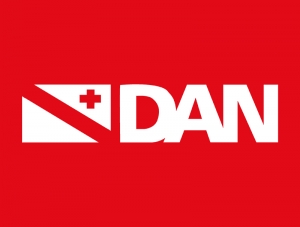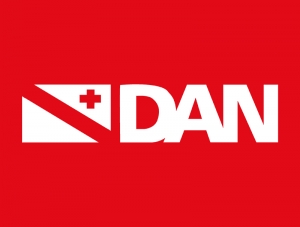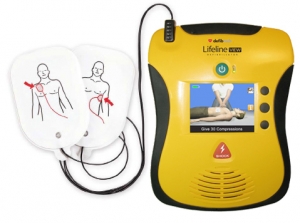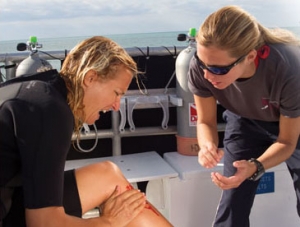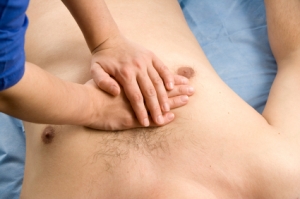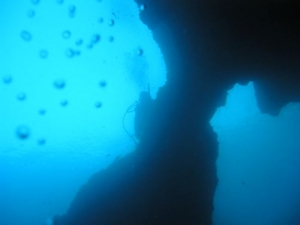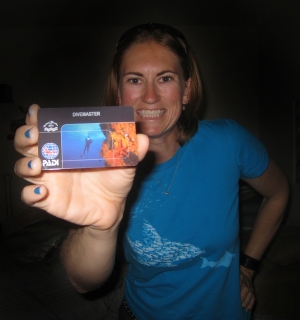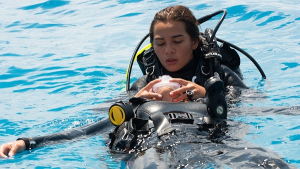Tassos Marinos
BLS & First Aid & AED
BLS & AED
BLS & First Aid
Automated External Defibrillator (AED)
DAN Automated External Defibrillation course (AED) represents entry level training designed to educate the general diving public (and interested non-divers) to better recognise the warning signs of Sudden Cardiac Arrest and administer first aid using Basic Life Support techniques and an Automated External Defibrillator while activating the local emergency medical services, (EMS) and / or arranging for evacuation to the nearest appropriate medical facility.
Course Objective
This course is designed to train and educate the general diving (and qualified non-diving) public in the techniques of using an automated External Defibrillator (AED) for victims of a cardiac arrest. In addition, this course also reviews first aid (and CPR) procedures using Basic Life Support techniques. This program also provides an excellent opportunity for experienced divers and instructors to continue their education.
Learning Objectives
At the end of this programme participants will be able to:
Recognise the warning signs of sudden cardiac arrest.
Provide Basic Life Support while setting up the automated external defibrillator.
Provide basic life support with an AED.
Care for and maintain an AED.
The nature and scope of this course is limited to training divers and interested non-divers such as boat captains, water enthusiasts and non-diving family members to provide emergency cardiac care with an Automated External Defibrillator.
This course does not provide training for cardiopulmonary resuscitation (CPR) or scuba diving rescue. The training exercises of this course presuppose that the ill or injured diver has already been brought to shore or is aboard the boat.
First Aid
The DAN First Aid course represents training designed to educate persons with a CPR/BLS certification in providing First Aid to adult victims with non immediately life threatening injuries.
Although the course was designed to be taught together with the DAN BLS course, it can also be offered as extra module to those who already have a DAN BLS or other BLS certification, respecting ERC guidelines. In a real accident situation First Aid skills are the next step after providing effective BLS.
Course Objective
The DAN First Aid provider programme is designed to teach the knowledge and skills needed to
provide first aid to Adults in non - immediately life threatening situations (or after having provided BLS in life threatening situations).
First Aid consists out of several techniques that relieves pain, stop injury from getting worse and can determine the type of injury or illness.
Recommended Minimum Hours of Training
Knowledge development (lecture) hours = 3-4
Skills development (practice) hours = 5-6
This course should be taught as an eight - ten hour module. The time needed to teach the course varies and depends on many factors including the number of students and their ability to process the educational components of the program.
Learning Objectives
At the end of the DAN First Aid programme, course participants will be able to:
Explain what is first aid and why to use these techniques
Perform an injury assessment
a. Describe how to react if a head or spinal injury is expected
Perform an illness assessment including taking vital signs and the “SAMPLE” procedure
Describe the signs, symptoms and first aid techniques for the major medical emergencies:
a. Breathing difficulties
b. Hyperventilation
c. Asthma
d. Heart problems
e. Severe abdominal pain
f. Altered level of consciousness
g. Allergic reaction
h. Diabetic emergencies (hyperglycaemia and hypoglycaemia)
i. Poisoning (swallowed, inhaled and absorbed poison)
j. Stroke
k. Convulsions
l. Alcohol and drug intoxication
Secure and bandage a wound
Splint a dislocated or fractured limb
a. Explain when it is necessary to immobilise the injured limb
Lift and move an injured person by using an adequate technique
a. Explain when it is necessary to move/lift an injured person
b. List the potential hazards when moving/lifting an injured person
c. Explain at least 2 techniques to move/lift an injured person (Rautek method and log roll)
Describe the signs, symptoms and first aid techniques for the following temperature related
injuries
a. Mild and severe hypothermia
b. Frostbites
c. Heat exhaustion
d. Heat stroke
e. Burns
Basic Life Support (BLS)
The DAN Basic Life Support (BLS) course will not only train divers and non-divers to resuscitate an injured person with a circulatory arrest, but can also prevent a person from getting in that condition. External bleeding, choking and shock can lead to severe circulatory and respiratory problems. The DAN BLS course will prepare you to react in the correct way, when accidents happen.
Course Objective
The Basic Life Support course, represents entry-level training designed to educate persons in providing Basic Life Support techniques to adult victims with life threatening injuries, while activating the local medical services.
The DAN Basic Life Support provider ("DAN BLS Provider") programme is designed to teach the knowledge and skills needed to provide Basic Life Support (BLS) to adult victims. BLS consists out of several First Aid techniques that support (or might restore) life. At the end of the course the DAN BLS provider will be able to recognise an emergency, activate the EMS and provide early BLS, while waiting for an AED or Advanced Life support to arrive at the scene of the accident. Early Access to the EMS and early BLS are 2 of the 4 links in the chain of survival.
Learning Objectives
At the end of this programme, DAN Basic Life Support, course participants will be able to:
Explain basic Anatomy and Physiology.
List the 4 links of the “chain of survival”
Explain why BLS is important
State the goal of BLS and resuscitation
Recognise danger and perform a Scene Safety Assessment
Protect themselves against cross infection
Describe the function of chest compressions and ventilations
Explain how to avoid Gastric distension
Check responsiveness
Reassure an injured person
Open the airway
Check for normal breathing
Activate the EMS
Perform chest compressions and rescue breathing – CPR
List the advantages of a ace shield and resuscitation mask
Explain the advantage of oxygen during resuscitation
Explain the importance of defibrillation
State the most common cause of chocking
Describe the difference between mild and severe airway obstruction
Provide care for choking
Explain why an unconscious, breathing victim must be placed in the recovery position
Place an unconscious, breathing person in the recovery position
Describe the function of the blood
Provide care for (severe) external bleeding
Explain what is shock
Name at least 3 causes of shock
List at least 7 warning signs of shock
Provide care for injured persons in shock
Peak Performance Buoyancy / Private
PADI Peak Performance Buoyancy Course Details
Float effortlessly, drifting over reefs. Be the diver you want to be, with ultimate buoyancy control, able to hover close to the bottom and examine underwater organisms without touching them.
Buoyancy skills separate the good divers from the great divers. In the Peak Performance Buoyancy Specialty course, you will learn to how to precisely weight yourself for optimum control, poise and balance. You learn to ascend and descend so effortlessly, it seems like you only think about it and it happens. By mastering streamlining, you move through the water cleanly, efficiently and gracefully. You swim near fragile environments without harm to them or yourself.
Get the buoyancy control great divers have with PADI Peak Performance Buoyancy
PADI Deep Diver course / Private
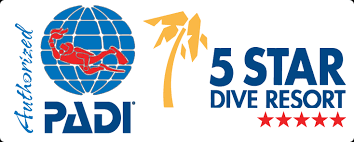
The Deep Diver Specialty course offers you the opportunity of a lifetime - going deep to see things others can only dream about.
Although this is not a decompression techniques course, you will learn about decompression procedures including: "Blue" and reference descents and ascents, longer safety stops, the use of the deco SMB, nitrogen narcosis and decompression sickness theory and the use of dive computers including avoiding the need for stage decompression. Your course will also include teachings on the purpose, problems, hazards, planning, preparation, equipment, air supplies, personnel, techniques, gas management, emergency procedures, and depth limits for recreational diving. Deep diving is defined as dives made between 60 feet / 18 meters and 130 feet / 40 meters.
Dive site
Our dive center is located right by the sea, offering direct access to a local dive site with clear, crystal waters and excellent visibility. The maximum depth ranges between 17 and 18 meters. The site is rich in diverse marine life, including octopuses, rockfish, scorpionfish, nudibranchs, schools of bream, triggerfish, stingrays, lionfish, and much more.
Shore diving is an affordable and flexible way to explore the underwater world, without the need for boat logistics.
It’s ideal for any time of the day, and our site is perfect for all levels of divers—whether you are training, refreshing your skills, or are an advanced diver.
The dive begins with a slow, easy entry from the beach to a sandy plateau between 0–5 meters, offering calm, pool-like conditions.
This is an ideal spot to practice breathing, swimming, and buoyancy, especially for novices or those who haven't dived in a while.
A short swim from this plateau, you’ll find a gentle slope leading down to a second plateau at 12–17 meters.
Here, you can find replicas of Greek statues on the seabed, a unique and scenic spot for underwater photography.
The seafloor is a mix of sand, rock, seagrass, and Posidonia oceanica fields, supporting an unexpectedly rich variety of marine life for a shore dive.
Marine Life in Kos
Typical marine life you might encounter includes octopuses, rockfish, scorpionfish, nudibranchs, schools of bream, triggerfish, stingrays, lionfish, and more. Occasionally, you might spot amberjacks, small tunas, or Mediterranean barracudas hunting in the blue. Some species are unique to our waters, while others are Lessepsian immigrants from the Red Sea.
Padi Divemaster
Here is our Padi Divemaster internship program
Do you have a deep and abiding passion for diving? Or, do you merely love it with all of your heart? If so, you should consider doing what you love for a living: become a PADI Divemaster.
When you Join the Tribe™ by becoming a PADI Divemaster, you align yourself with the largest and most respected dive tribe in the world—that of PADI Professionals. These are PADI Divemasters and Instructors sharing a passion for diving and an active concern for the health of the world’s underwater habitats.
PADI Divemaster Course
Looking for the first step in working with scuba as a career? Your adventure into the professional levels of recreational scuba diving begins with the PADI Divemaster program. Working closely with a PADI Instructor, in this program you expand your dive knowledge and hone your skills to the professional level. PADI Divemaster training develops your leadership abilities, qualifying you to supervise dive activities and assist instructors with student divers. PADI Divemaster is the prerequisite certification for both the PADI Assistant Instructor and PADI Open Water Scuba Instructor certifications
What You Learn
During the PADI Divemaster program, you learn dive leadership skills through both classroom and independent study. You complete water skills and stamina exercises, as well as training exercises that stretch your ability to organize and solve problems as well as help others improve their scuba. You put this knowledge into action through a structured internship or series of practical training exercises.
As you progress through your Divemaster course, you’ll expand your diving knowledge, hone you skills and increase your confidence. Then, as a PADI Divemaster, you’ll use these attributes to lead, mentor and motivate other divers and experience the joy of seeing them transformed by the majesty of the the acquatic realm.
Get a Life as a PADI Divemaster and scuba dive for work anywhere in the world!
What You Can Teach
After becoming certified as a PADI Divemaster you will be authorized to:
Supervise both training and non-training-related activities by planning, organizing and directing dives
Assist a PADI Instructor during the training sessions for any PADI Diver course
Conduct the PADI Skin Diver course and PADI Discover Snorkeling program
Conduct the PADI Discover Local Diving experience
Conduct the PADI Scuba Review program
If qualified as a Discover Scuba Diving Leader, independently conduct the PADI Discover Scuba Diving program.
Earn the PADI Digital Underwater Photographer Specialty Instructor rating to be able to teach the PADI Digital Underwater Photographer specialty.
Guide Open Water Diver course students on the tour portion of Open Water Dives 2, 3 and 4 at a 2:1 ratio, under the instructor’s indirect supervision.
Accompany Open Water Diver students under the indirect supervision of a PADI Instructor during:
surface swims to and from the entry/exit point and during navigational exercises
when the instructor conducts a skill, such as an ascent or descent, a Divemaster can remain with other student divers (with an individual student or buddy team)
Accompany student divers during Adventure Dives or Specialty training dives under the indirect supervision of a PADI Instructor.
Conduct the PADI Seal Team Skin Diver Specialist AquaMission
Conduct subsequent dives under an instructor’s indirect supervision for Discover Scuba Diving participants after participants have satisfactorily completed the first dive with a PADI Instructor.
Teach Emergency First Response courses after successfully completing an Emergency First Response Instructor course.
At a glance, compare what you can teach when you continue your professional diver education.
Expand your scuba diving knowledge and experience as a PADI Divemaster
The Scuba Gear You Use
You use all the basic scuba equipment and some scuba accessories such as a dive slate, dive knife, compass, dive watch, etc.
It is highly recommended that you own all of your own scuba equipment, as familiarity with personal gear improves general scuba diving skills. You can find most everything at your local dive shop
The Learning Materials You Need
The PADI Divemaster crewpak includes:
PADI Divemaster Manual
Divemaster slates
PADI Instructor Manual
The Encyclopedia of Recreational Diving - a comprehensive overview of diving physics, physiology, and equipment
Scuba Tune-up Guidebook
PADI Professional Log
DSD Cue Cards
PADI Pro Bag
PADI Divemaster Application package
There are other required materials that a Divemaster Candidate will need but may have received them during other PADI programs so they have not been included in the Divemaster Crew-Pak. Please ask your PADI Instructor for the full list of required materials that you will need for the course
To purchase Crew-Paks, contact your local PADI Five Star Dive Shop or Resort.
Prerequisites
To take this course, you must be:
18 years old
A PADI Advanced Open Water Diver (or qualifying certification from another training organization)
A PADI Rescue Diver (or qualifying certification from another training organization)
An Emergency First Response Primary and Secondary Care (or qualifying first aid and CPR training from another organization) course completion within the past 24 months.
Have at least 40 dives to begin the course and 60 for certification
Be fit for diving and submit a Medical Statement (PDF) signed by a physician within the last 12 months.
PADI Rescue Diver course / Private

PADI Rescue Diver Course Details
Challenging and rewarding best describes the PADI Rescue Diver course. This course will expand your knowledge and experience level. Rescue Divers learn to look beyond themselves and consider the safety and well being of other divers. Although this course is challenging, it is a rewarding way to build your confidence. Rescue Diver training will prepare you to prevent problems and, if necessary, manage dive emergencies. Many divers say this is the best course they’ve ever taken. You'll cover:
- Self-rescue and diver stress
- Emergency management and equipment
- Panicked diver response
- In-water rescue breathing protocols
- Egress (exits)
- Dive accident scenarios


